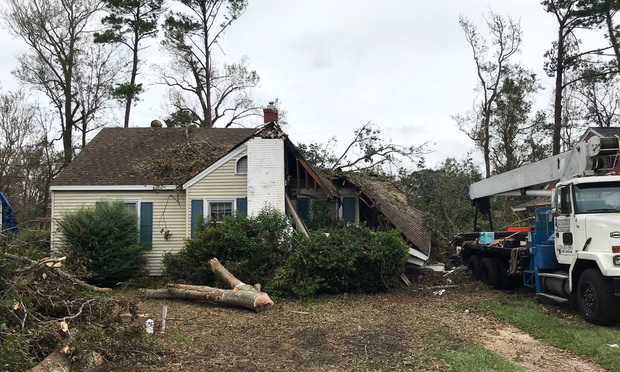Insurance Litigation Balloons in Insurer-Friendly Federal Courts, Report Finds
A new report found major increases in homeowner, automobile and most other types of insurance disputes filed in federal court, where insurers are significantly more likely to prevail over claimants.
October 11, 2018 at 04:42 PM
5 minute read
The original version of this story was published on Law.com
A report analyzing data from federal insurance cases filed since 2009 found a major upswing in the numbers of such cases over the last several years, and confirms that federal courts are far more likely to rule in favor of insurers than claimants.
The Insurance Litigation Report released by Lex Machina Tuesday sifted data from more than 93,000 insurance cases filed between 2009 and 2017. It reveals a large jump in automobile and uninsured/underinsured motorist claims, which rose by 39 percent and 50 percent, respectively.
There was an even larger spike in homeowner claims, which rose by 80 percent.
Read the report:
Other insurance cases, such as those involving disability, long-term care and commercial property claims, also rose by almost 25 percent.
Top Plaintiff Firms/Cases Filed
- Merlin Law Group – 901
- Pandit Law Firm – 855
- The Voss Law Firm – 325
- Ellis, Ged & Bodden – 250
- Daly & Black – 249
- The Mostyn Law Firm – 241
- Ketterman Rowland & Westlund – 236
- Hinshaw & Culbertson – 226
- Wilson Elser Moskowitz Edelman & Dicker – 198
- Gauthier, Houghtaling & Williams – 179
- Speights & Worrich – 178
- Boyer, Hebert, Abels & Angelle – 150
- McClenny Moseley & Associates – 150
- The Aguilera Law Group – 147
- Cozen O'Connor – 144
At the same time, life insurance claims dropped by 20 percent over the same period, the report said.
While claims cases are up, insurers found the courts to be friendly places to handle them, particularly in cases claiming bad faith, which resolved in favor of insurance companies more than 90 percent of the time.
Insurers also emerged victorious in 85 percent of duty to indemnify cases and in 80 percent of duty to defend cases, it said.
The report found there was an upswing in hurricane-related homeowner claims, which spiked dramatically due to natural disasters like Hurricane Ike in 2008 and Hurricane Sandy in 2012.
Four of the five jurisdictions with the highest numbers of such claims are in Florida, Louisiana and Texas, all states which have suffered extensively from hurricanes in recent years, the report said.
Nonetheless, even when hurricane-related claims are removed from consideration, homeowner claim filings increased by more than 90 percent, it said.
Top Defendant Firms/Cases Terminated
- Nielsen & Treas – 1,378
- Thompson Coe Cousins & Irons – 905
- Stradley Ronon Stevens & Young – 732
- Kennedys CMK – 649
- United States Attorneys' Offices – 332
- Hinshaw & Culbertson – 330
- Lewis Brisbois Bisgaard & Smith – 329
- Butler Weihmuller Katz Craig – 303
- Robinson & Cole – 281
- Wilson Elser Moskowitz Edelman & Dicker – 269
- Roerig Oliveira & Fisher – 256
- Carter, Ledyard & Milburn – 252
- Cozen O'Connor – 238
- Marshall, Dennehey, Warner, Coleman & Goggin – 231
- Sedgwick – 227
Regarding auto and UM cases, it said increasing medical costs “are likely driving the increase in the number of cases involving automobile insurance in the federal courts. As costs increase, more such cases will meet federal court jurisdictional requirements.”
Under federal rules of civil procedure, a case can be removed to federal court if the dispute is between parties in different states and the amount in controversy is more than $75,000.
Insurers were almost five times as likely to win life insurance disputes, and two-thirds of such cases resolved on summary judgment, the report said.
In business liability cases, insurers were three times as likely to prevail than plaintiffs in cases decided pretrial.
“However, in cases that went to trial, claimants prevailed more than 55 percent of the time,” it said.
The report also analyzed the amount of time it took for courts to resolve insurance cases in four major circuits in California, Illinois, New York and Texas.
It found that California's Central District was the fastest, taking an average of 343 days to rule on summary judgment, and 493 days to get to trial.
Texas' Southern District was even faster in terminating insurance cases pretrial, taking an average of 207 days. But it was the slowest to reach trial at 672 days.
Lex Machina legal researcher Ron Porter said the analysis should help insurers and attorneys working to dig into data regarding claims disputes.
“For instance, without the ability to remove hurricane data from the equation, spikes in hurricane-related case filings might have masked an otherwise huge increase in non-hurricane homeowner case filings,” said Porter in a statement accompanying the report's release.
This content has been archived. It is available through our partners, LexisNexis® and Bloomberg Law.
To view this content, please continue to their sites.
Not a Lexis Subscriber?
Subscribe Now
Not a Bloomberg Law Subscriber?
Subscribe Now
NOT FOR REPRINT
© 2025 ALM Global, LLC, All Rights Reserved. Request academic re-use from www.copyright.com. All other uses, submit a request to [email protected]. For more information visit Asset & Logo Licensing.
You Might Like
View All
Lavish 'Lies' Led to Investors Being Fleeced in Nine-Figure International Crypto Scam
3 minute read
SEC Puts Beat Down on Ex-Wrestling CEO Vince McMahon for Not Reporting Settlements
3 minute read
DOJ Files Antitrust Suit to Block Amex GBT's Acquisition of Competitor
Trending Stories
- 1'It's Not Going to Be Pretty': PayPal, Capital One Face Novel Class Actions Over 'Poaching' Commissions Owed Influencers
- 211th Circuit Rejects Trump's Emergency Request as DOJ Prepares to Release Special Counsel's Final Report
- 3Supreme Court Takes Up Challenge to ACA Task Force
- 4'Tragedy of Unspeakable Proportions:' Could Edison, DWP, Face Lawsuits Over LA Wildfires?
- 5Meta Pulls Plug on DEI Programs
Who Got The Work
Michael G. Bongiorno, Andrew Scott Dulberg and Elizabeth E. Driscoll from Wilmer Cutler Pickering Hale and Dorr have stepped in to represent Symbotic Inc., an A.I.-enabled technology platform that focuses on increasing supply chain efficiency, and other defendants in a pending shareholder derivative lawsuit. The case, filed Oct. 2 in Massachusetts District Court by the Brown Law Firm on behalf of Stephen Austen, accuses certain officers and directors of misleading investors in regard to Symbotic's potential for margin growth by failing to disclose that the company was not equipped to timely deploy its systems or manage expenses through project delays. The case, assigned to U.S. District Judge Nathaniel M. Gorton, is 1:24-cv-12522, Austen v. Cohen et al.
Who Got The Work
Edmund Polubinski and Marie Killmond of Davis Polk & Wardwell have entered appearances for data platform software development company MongoDB and other defendants in a pending shareholder derivative lawsuit. The action, filed Oct. 7 in New York Southern District Court by the Brown Law Firm, accuses the company's directors and/or officers of falsely expressing confidence in the company’s restructuring of its sales incentive plan and downplaying the severity of decreases in its upfront commitments. The case is 1:24-cv-07594, Roy v. Ittycheria et al.
Who Got The Work
Amy O. Bruchs and Kurt F. Ellison of Michael Best & Friedrich have entered appearances for Epic Systems Corp. in a pending employment discrimination lawsuit. The suit was filed Sept. 7 in Wisconsin Western District Court by Levine Eisberner LLC and Siri & Glimstad on behalf of a project manager who claims that he was wrongfully terminated after applying for a religious exemption to the defendant's COVID-19 vaccine mandate. The case, assigned to U.S. Magistrate Judge Anita Marie Boor, is 3:24-cv-00630, Secker, Nathan v. Epic Systems Corporation.
Who Got The Work
David X. Sullivan, Thomas J. Finn and Gregory A. Hall from McCarter & English have entered appearances for Sunrun Installation Services in a pending civil rights lawsuit. The complaint was filed Sept. 4 in Connecticut District Court by attorney Robert M. Berke on behalf of former employee George Edward Steins, who was arrested and charged with employing an unregistered home improvement salesperson. The complaint alleges that had Sunrun informed the Connecticut Department of Consumer Protection that the plaintiff's employment had ended in 2017 and that he no longer held Sunrun's home improvement contractor license, he would not have been hit with charges, which were dismissed in May 2024. The case, assigned to U.S. District Judge Jeffrey A. Meyer, is 3:24-cv-01423, Steins v. Sunrun, Inc. et al.
Who Got The Work
Greenberg Traurig shareholder Joshua L. Raskin has entered an appearance for boohoo.com UK Ltd. in a pending patent infringement lawsuit. The suit, filed Sept. 3 in Texas Eastern District Court by Rozier Hardt McDonough on behalf of Alto Dynamics, asserts five patents related to an online shopping platform. The case, assigned to U.S. District Judge Rodney Gilstrap, is 2:24-cv-00719, Alto Dynamics, LLC v. boohoo.com UK Limited.
Featured Firms
Law Offices of Gary Martin Hays & Associates, P.C.
(470) 294-1674
Law Offices of Mark E. Salomone
(857) 444-6468
Smith & Hassler
(713) 739-1250












